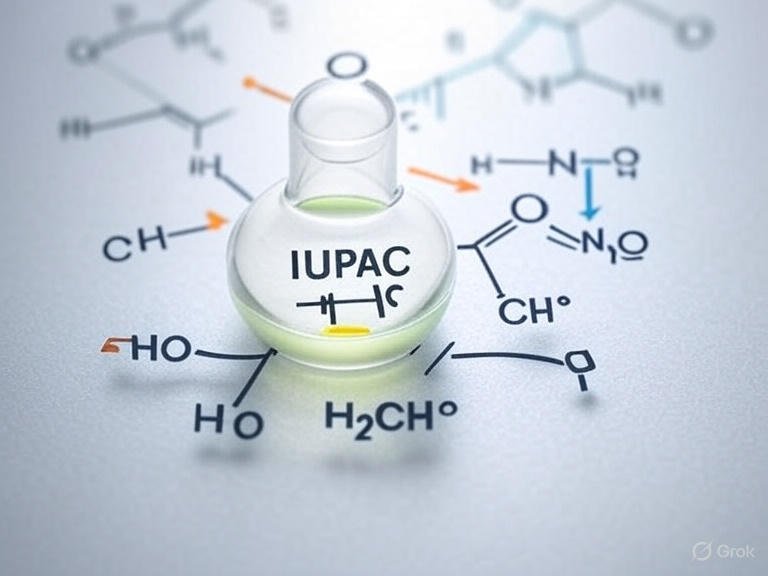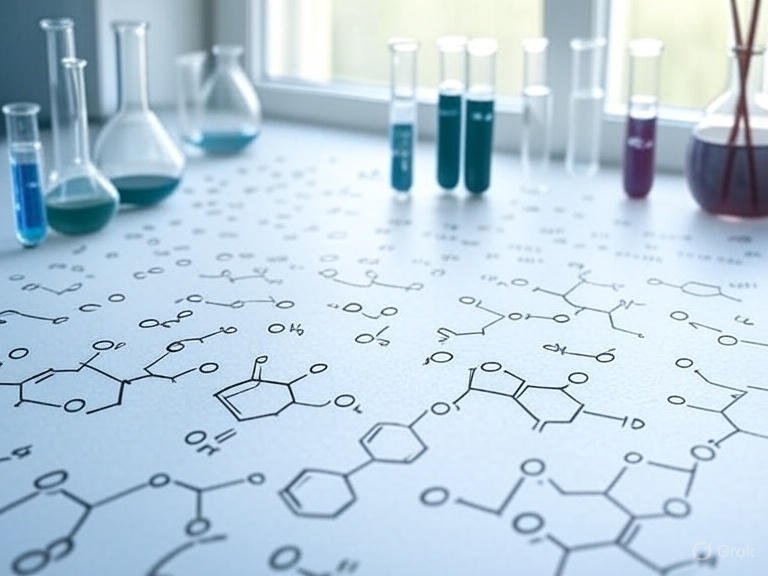Chemical formulas are like a special code. They show what a thing is made of. They tell how its parts stick together. But not every formula you see is real. Some are fake. They show up in bad websites or wrong books. Learning the rules for real chemical formula rules helps you know what’s true. This guide teaches you how to spot real formulas. It uses easy steps. You’ll learn about IUPAC naming, how to read formulas, and how to check if a chemical is real. Let’s start!
Why Chemical Names Are Important
Chemical formulas are not just letters and numbers. They follow rules. These rules help scientists, students, and teachers understand the same thing. A real formula shows what a substance is made of. It shows how parts connect. If a formula is wrong, it can confuse people. It might cause mistakes in science work. Fake formulas often appear in bad online articles. They trick people who don’t know the rules. By learning these rules, you can find the fakes. You’ll feel smart about what you read.
I’m Ramona P. Woodmansee. I study how wrong information spreads online. I focus on science. My job is to help you know what’s real. This article gives you easy, true steps to check chemical formulas. You won’t get fooled!
The Main Rules – IUPAC Naming Basics
What Is IUPAC?
IUPAC means International Union of Pure and Applied Chemistry. It’s a group that makes rules for naming chemicals. Everyone in the world uses these rules. Think of IUPAC as the boss of chemical names. They make sure water is called H₂O everywhere. It’s never something silly.
How Naming Works
IUPAC has easy rules for naming chemicals. The rules change if the chemical has carbon (like sugar) or not (like salt). Here’s how they work:
- Prefixes: These show how many carbon atoms are in a chemical. “Meth-” means one carbon. “Eth-” means two. “Prop-” means three. For example, methane (CH₄) has one carbon. Ethane (C₂H₆) has two.
- Suffixes: These tell what kind of chemical it is. “-ane” means a simple chemical with single connections, like propane (C₃H₈). “-ol” means it has an alcohol part, like ethanol (C₂H₅OH). “-ic acid” means it’s an acid, like acetic acid (CH₃COOH).
- Special Parts: Some chemicals have special parts that make them act in a certain way. For example, an alcohol part (-OH) makes ethanol an alcohol.
Chemicals without carbon, like sodium chloride (NaCl), use different rules. They name the metal first (like sodium) and the non-metal second (like chloride). IUPAC keeps names clear and the same everywhere.
Carbon vs. Non-Carbon Names
Chemicals with carbon, like methane, are called organic. Their names use prefixes and suffixes to show the carbon chain and special parts. Chemicals without carbon, like iron sulfate (Fe₂(SO₄)₃), are called inorganic. They focus on the elements and their electric charges. Knowing this helps you see if a name is right.
How to Read a Real Chemical Formula

A chemical formula is like a recipe. It shows what pieces make a substance. It shows how many of each piece. But it must follow rules to be real. Let’s look at the parts.
Element Letters
Every element has a letter code. These are on the periodic table. For example, H is hydrogen. O is oxygen. A real formula only uses these codes. If you see strange letters, like “Xy” or “Zz,” it’s not real. Look at the periodic table to check.
Tiny Numbers
Tiny numbers come after an element’s letter. They show how many atoms of that element are in the chemical. For example, in H₂O, the “2” means two hydrogen atoms. No tiny number means one atom, like the O in H₂O. These numbers must work for the chemical to be real.
Brackets and Electric Charges
Some formulas use brackets to group parts. For example, in iron sulfate (Fe₂(SO₄)₃), the (SO₄) is a group called sulfate. The tiny “3” outside means three sulfate groups. Electric charges, like 2+ or 3-, show how atoms balance. For example, Fe²⁺ in Fe₂(SO₄)₃ means iron has a 2+ charge. These must follow science rules to be real.
Water in Chemicals
Some chemicals have water attached. For example, copper sulfate pentahydrate (CuSO₄·5H₂O) has five water parts. The “·5H₂O” shows this. This is common in non-carbon chemicals. It must be written right.
Examples of Real Formulas
Here are some real formulas:
- CH₃COOH (acetic acid): It has two carbons, four hydrogens, and two oxygens in a special order.
- NaCl (sodium chloride): It’s salt with one sodium and one chlorine.
- Fe₂(SO₄)₃ (iron sulfate): It has two iron atoms and three sulfate groups, balanced by charges.
If a formula doesn’t look like these, it might be fake.
Why Shape and Connections Matter
A chemical formula isn’t just letters and numbers. It must show a chemical that can exist. This depends on its shape and how its pieces connect.
What Makes a Chemical Work?
Atoms in a chemical join with connections called bonds. Each element can only make a certain number of bonds. This is called valency. For example:
- Carbon (C) makes four bonds.
- Hydrogen (H) makes one bond.
- Oxygen (O) makes two bonds.
In methane (CH₄), one carbon connects to four hydrogens. This works because carbon uses all four bonds. If a formula shows carbon with five bonds, like CH₅, it can’t exist. It’s not real.
Kinds of Connections
Connections can be single, double, or triple. A single connection shares one pair of electrons, like in ethane (C₂H₆). A double connection shares two pairs, like in carbon dioxide (CO₂). A triple connection shares three pairs, like in nitrogen gas (N₂). The formula must match the connections the elements can make. For example, CO₂ works because oxygen makes two bonds, and carbon makes four (two double bonds to two oxygens).
Finding Impossible Shapes
Some formulas look okay but show chemicals that can’t exist. For example, they might have too many bonds. Or the atoms don’t balance electrically. Scientists draw the chemical’s shape to check if it works. If the shape is wrong, the formula is fake.
Warning Signs of Fake Names
Fake chemical names or formulas don’t follow IUPAC rules. Here are signs to watch for.
Mixing Wrong Rules
Carbon chemicals use prefixes like “meth-” or “eth-.” Non-carbon chemicals use elements and charges. A fake name might mix these. For example, calling NaCl “methochloride” is wrong. Sodium chloride is non-carbon. It doesn’t use carbon prefixes.
Messy Naming
Real formulas follow clear patterns. If you see missing tiny numbers (like H2O instead of H₂O) or wrong endings (like calling methanol “methanic”), it’s likely fake. For example, ethanol is C₂H₅OH, not C₂H₅O or C₂H₆OH. Wrong numbers or parts break the rules. A common fake is HCOOCH CH2 H2O. It looks like a formula but isn’t a real chemical. It’s used in bad online articles to trick people.
No Clear Meaning
A real formula makes sense. It comes with a name and explanation. If you see a random string of letters with no meaning, it might be made up. For example, CH₃COOH is acetic acid with a clear shape. Fake ones don’t have this.
Tools to Check Chemical Names
You don’t need to guess if a formula is real. Free tools can help. Here’s how to use them.
Free Tools
- IUPAC Blue Book: This is the main guide for carbon chemical names. It’s online and shows all the rules.
- PubChem: A list of chemicals. Type a name or formula to see if it’s real. It shows the chemical’s shape.
- ChemSpider: Another list to check chemicals. It shows names, formulas, and details.
- Royal Society of Chemistry (RSC): Has guides and tools for IUPAC rules.
Checking with Shape Tools
Tools like ChemDraw or Avogadro let you draw a chemical’s shape. If the shape works, the formula is probably real. For example, type CH₃COOH into PubChem. It shows acetic acid’s shape. If a formula’s shape doesn’t work, it’s not real.
Example of Checking
Suppose you see C₆H₁₂O₆ online. Is it real? Type it into PubChem. It matches glucose, a real sugar. The site shows its shape and proves it follows IUPAC rules. Now try a fake formula, like C₅H₁₂O₇. PubChem won’t find it. Or it shows it’s not stable. This quick check keeps you from believing wrong info.
I’m Ramona P. Woodmansee. I’ve used tools like PubChem and ChemSpider for my articles. They help me make sure readers get true facts. These tools are easy and free. You can use them too!
How to Find Fake Chemistry Online
Fake chemistry shows up in bad websites. These sites use made-up terms to trick Google. I’ve studied how these sites confuse people. By using IUPAC rules and tools like PubChem, you can avoid tricks. Here are tips:
- Check the website. Is it a trusted place like RSC or a strange blog?
- Look for meaning. Does the formula have a name and story?
- Use lists like PubChem. If they don’t know the formula, be careful.
Using Real Chemical Formula Rules
Learning real chemical formula rules is like having a magic power. You can read any chemical name or formula and know if it’s real. This helps students, teachers, or anyone curious. It keeps you safe from bad info online. For example, knowing CH₃COOH is acetic acid and follows IUPAC rules makes you feel strong in science.
Start with IUPAC naming basics. Learn prefixes, suffixes, and how atoms connect. Then use tools like PubChem to check. If a formula doesn’t follow rules, it’s probably fake. Practice a lot. You’ll get good at spotting fakes fast.
Why Chemistry Rules Matter
Chemistry rules keep science clear. They keep it safe. A wrong formula can cause mistakes in labs. It can confuse students in class. By learning IUPAC naming basics and structural chemistry rules, you think like a scientist. This helps you find fake info and share true facts.
I’m Ramona P. Woodmansee. I write for blogs about clear, true science. I want to help you understand chemistry. Whether you’re checking a formula for school or finding fakes online, these rules help you.
Conclusion
Knowing real chemical formula rules helps you master chemistry. From IUPAC naming basics to finding fake formulas, this guide gives you tools to check chemicals like an expert. Use PubChem and ChemSpider to check names and shapes. Look for clear names and right connections. These steps keep you away from fake chemistry. They build trust in what you learn.
Want to try it? Next time you see a chemical formula online, check if it follows IUPAC rules. Use a tool like PubChem to be sure. Share what you find in the comments! Let’s make science true together.
Disclaimer: This article is for learning only. It does not give expert science advice. Always check facts using trusted websites like PubChem or university pages. If you’re doing a school project or working in a lab, ask a science teacher or expert for help. The writer is not responsible for how you use this information. Please use it to learn, not for serious work.
